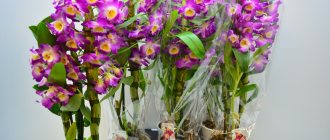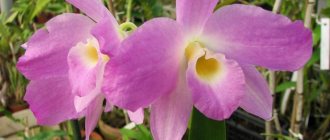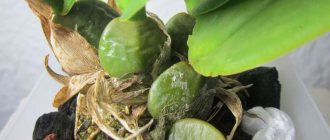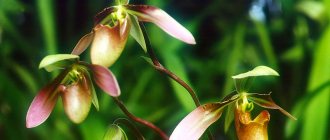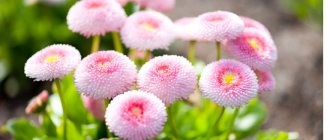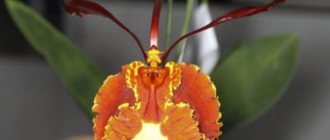Post-procedure care
Temperature, lighting and humidity
After transplanting, it is recommended to remove the dendrobium to a room with high humidity or provide it with daily spraying and sufficient light (10-15 hours a day).
But under no circumstances should you install it in direct sunlight. The optimal room temperature should be between 22-25° C.
If the transplant is carried out for the purpose of propagation, then the plant is removed to a shaded place with a temperature of about 20° C.
When and how to water?
The plant is not watered immediately after transplantation. The root system must dry well to avoid rot. Watering begins after 7-10 days, carefully, without getting on the leaves, along the edge of the pot onto the substrate.
When and what to feed?
Additional nutrition is provided only during the period of active growth. And since active growth has not yet begun after transplantation, the orchid does not need feeding.
The only thing recommended to do during this period is spraying the leaves with a glucose solution.
Growing problems
If the grower does not follow proper care, problems arise during cultivation. They require treatment to prevent the plant from dying.
Yellow leaves
Yellowness of the leaf blade develops for a number of reasons:
- the spread of direct sunlight, causing damage and burns;
- insufficient amount of fertilizing, leading to wilting;
- development of parasites that suck out all plant sap.
If the reason is improper care, it is enough to normalize it. When infection or parasites spread, an insecticide is prescribed.
Dendrobium does not bloom for a long time
The problem often develops without a reason. This is normal. The plant accumulates a large amount of nutrients in order to form colorful inflorescences in the next growing season. The symptom may appear due to the following factors:
- lack of sufficient light, fertilizing, fertilizers;
- development of bacterial, fungal, parasitic infection;
- rest period;
- use of nitrogen-containing fertilizers.
All factors can be eliminated in a timely manner if quality home care is started.
Flowers and buds fall
Falling off can develop for physiological or pathological reasons:
- preparation for the rest period;
- completion of shoot flowering;
- improper home care with lack of fertilizer or high-quality lighting;
- severe drought when care rules for watering are ignored.
Falling leaves during the growing season is a serious sign. You need to start treatment immediately.
Dendrobium Pests
Pests rarely form, mainly if you take the orchid to the balcony or veranda near outdoor plants. The following parasites have been isolated:
- spider mite, scale insect;
- aphids, mealybugs.
If the insects have just begun to develop, removing them is easy. Large specimens are removed by hand, the rest are washed off with a solution made from laundry soap. It is made in medium concentration in order to destroy parasites without harming the shoots. An insecticide is selected that is sufficient to kill insects but does not cause damage. For example, fitoverm.
Most people prefer a flower like an orchid due to its high-quality decorative effect. It can be grown at home, greenhouses, arboretums. The Dendrobium Nobile orchid is known for its trunks similar to bamboo. It forms beautiful, colorful buds. To maintain properties, high-quality care is provided. Then problems will not arise.
Basic care issues after flowering
Caring for a Dendrobium orchid after flowering at home is required so that the plant can please us again with its beautiful blooms as soon as possible. On average, this species blooms from 8 to 12 weeks and is one of the most popular varieties of orchids. The main condition that must be met in any situation is the difference between day and night temperatures.
The Dendrobium orchid is very popular among amateur gardeners.
After the orchid has bloomed, the first thing to do is:
- Stop watering;
- Get rid of the old peduncle;
- Ensure a decrease in temperature, namely: move the flower to a cooler place. This way it can get ready to bloom again.
Experienced gardeners recommend not placing the plant in a dark place, as it may “hibernate,” which means stopping growth.
The Dendrobium orchid reproduces in two ways:
- Propagation by cuttings;
- And propagation by peduncle.
IMPORTANT! For sufficient lighting, especially in winter, experts recommend purchasing a phytolamp.
Specifics of caring for Dendrobium in different periods
Home care methods depend on the growing period. It is necessary to follow the rules for Dendrobium Nobile to form flowers. Caring for dendrobium differs after purchase, during the dormant period and the growing season.
Actions after purchasing Dendrobium
Immediately after purchase, follow the following steps to preserve the structure of the orchid:
- replanting is not recommended, it is stressful for the plant;
- find the right location with enough sunlight, no drafts, and a warm temperature;
- water a little through the tray.
How to propagate?
Each reproduction method has its own technology, compliance with which will be the key to a positive result.
Dividing the bush
Dividing the dendrobium into 2 or more specimens is considered an effective method of propagation.
The main condition is that the plant has at least 6 shoots. Step by step process:
- the orchid is removed from the pot, the old substrate is removed;
- straighten the roots, cut off dry ones;
- determine the division sites so that for each part there are 2 pseudobulbs and the same number of young shoots;
- wounds are sterilized;
- planted in pre-prepared pots in dry soil;
- the next day, the flowers are watered and normal growing conditions are provided.
Cuttings
The peculiarity of dendrobium as a sympodial species of orchid is that the bush grows horizontally. As a result, new shoots are formed, and old ones lose leaves and reduce the decorative effect of the flower. But they are the ones that are suitable for the cutting method.
Stages of work:
- The shoot is separated at the root with a sterile knife from the mother bush.
- Cut into pieces of 10 cm.
- Wounds are treated with charcoal, cinnamon, and hydrogen peroxide.
- Sphagnum moss is placed in the container and moistened.
- The cuttings are laid out on it, covered with a lid or wrapped in a transparent plastic bag and secured.
- Keep at a temperature of +20-25 °C, ventilate once a day.
- If desired, spray 1-2 times with Epin solution.
- After 2-3 weeks, roots will begin to appear. Young plants are transplanted into ordinary pots.
When using the cutting method, dendrobium blooms for 2-3 years.
If germinated cuttings are exposed to low temperatures (from +15 °C and below), then flower stalks will grow from the buds instead of children. Such plants are not suitable as planting material and are thrown away.
Children
This method is considered the most popular and simplest. To stimulate the development of children, do the following:
- reduce watering;
- increase the temperature to +30 °C;
- humidity is increased to 70%;
- fertilize with fertilizer containing nitrogen.
A pseudobulb will appear from the awakening bud. When 4-5 leaves appear, 2-3 roots appear and the length of the shoot reaches 5-8 cm, the children are ready for planting.
Further actions:
- a sharp knife or blade is disinfected with alcohol;
- cut off the pseudobulb under its base;
- wounds are treated with activated carbon, cinnamon or brilliant green;
- the babies are left to dry for 1 day;
- prepare a small pot with a fine fraction substrate and plant the shoot there.
When planting, the growing point is not buried.
Water for the first time on days 2-4. During denrobium rooting, humidity is maintained at 70-80%, daylight hours are increased to 14 hours a day. The optimal temperature is +22-25 °C.
If children do not have roots, then it makes sense to stimulate their education.
Growing process:
- the seedling glass is filled with moss and watered;
- plant the shoot;
- place in a warm, illuminated place, spray periodically;
- When 3-4 roots are formed, they are planted in a pot using standard technology.
Children should not be placed in a glass of water. This will cause the plant to rot.
Dendrobium orchid species
Dendrobium - the most beautiful flower
Among the variety of species and varieties of orchids, it is impossible to single out any special variety that would gain universal popularity. They are all beautiful in their own way.
Dendrobium nobile
Photo: Dendrobium nobile
Dendrobium nobile
Vietnam and the Himalayas are considered its homeland. Shiny thick pseudobulbs are characterized by rapid growth and reach 0.5 m in length already in the first year of life. In the next season, flower stalks are formed, of which there are from 1 to 3 on one plant. The flowers are large, rich in color, up to 10 cm in diameter.
The natural-looking flowers are pure white, the tips of the petals are tinged with purple, the lip is cream, and the throat is dark purple in color. Hybrids have different colors and bloom several times a year.
Dendrobium phalaenopsis
Dendrobium phalaenopsis
Dendrobium phalaenopsis
The orchid got its name due to the identical shape of flowers with phalaenopsis. Naturally distributed in Australia.
Pseudobulbs, together with leathery glossy leaves, reach 0.7 m in length. The species simultaneously forms up to 10 flowers, 8 cm in diameter, which are located on a high peduncle. More often the petals are painted burgundy.
Flowering is long-lasting, up to 2 months. It falls at the end of November - beginning of December. Several peduncles may appear on the same pseudobulb in one season. The best type for novice gardeners.
Dendrobium moniliforme
Dendrobium moniliforme
Dendrobium moniliforme
Moniliforme is a miniature dendrobium. The stem of the bush reaches no more than 15 cm in height, the rosette is very beautiful. Inexperienced gardeners should have this species at home, as it is easy to care for, especially since it blooms with beautiful “butterflies”.
Dendrobium parishii
Dendrobium parishii
Dendrobium parishii
The hanging shoots of the epiphthous plant reach 0.3 m in length. There are also more powerful specimens.
The pointed oblong-lanceolate leaves grow up to 12 cm in length. Single flowers, painted in an amethyst-purple tone, bloom on the dendrobium. The rounded lip is densely strewn with purple-brown spots, the anther is purple, the column is snow-white. Characterized by summer flowering.
King's Dendrobium (Dendrobium kingianum)
Dendrobium kingianum
King's Dendrobium (Dendrobium kingianum)
Originally from Australia. The lower part of the cylindrical stems has a noticeable thickening, and at the top of the stem there are wide leaves.
Flowering is abundant, buds are formed in large quantities, in February. At this time, the King's dendrobium produces a long peduncle, on which 5 pink flowers bloom, exuding a pleasant aroma.
Dendrobium densiflorum
Dendrobium densiflorum
Dendrobium densiflorum
Found naturally in the Himalayas. Unusual coloring. All flowers have a rich orange color, which even slightly hurts the eye. Flowering is very abundant. Up to 50 flowers can bloom simultaneously on racemose inflorescences 0.3 m long.
You can learn more about representatives of the orchid family from the video below.
What can you grow from a seed at home? | TOP 28 Common and unusual plants | (Photo & Video) + Reviews
GENERAL INFORMATION:
In nature, Dendrobium parishii is found in China, Thailand, Vietnam, India, Burma and the Himalayas, where it grows epiphytically on trees at altitudes from 250 to 1,700 meters above sea level. Pseudobulbs are hanging, segmented, turn red in bright sun, up to 60 cm long and about 2-3 cm wide. The leaves are lanceolate, last for about a year, measuring 9-10 cm long and 3.5-3.7 cm wide. Peduncles are short, appearing in the upper third of the pseudobulbs. There are 1-3 fragrant flowers per peduncle. The flowers are shiny, deep pink with two darker spots inside the lip, about 4-6 cm in diameter. The upper sepal is lanceolate, measuring about 3-3.5 cm long and 1.3-1.5 cm wide. The lateral sepals are slightly fused at the back, forming something like a small spur, pointed at the tips, measuring 3-3.5 cm long and 1-1.3 cm wide. The petals are oval, grow slightly forward, measuring 3-3.5 cm long and 2 cm wide. The lip is in the shape of a folded paper bag, covers a column inside itself, has two darker spots inside (often with veins), the front part is shaggy. The column is short, purple at the tip.
Synonyms for this type of orchid are: Callista parishii, Callista rhodopterygia, Dendrobium polyphlebium and Dendrobium rhodopterygium.
TEMPERATURE:
This type of orchid belongs to a moderate-warm temperature regime, and during the year it is recommended to keep the plants under the following conditions:
Summer:
not higher than + 35 °C;
Winter:
10-22 °C.
To successfully grow Dendrobium parishii at home, it is necessary that the night temperature is always at least 4-10 °C lower than the daytime temperature. For example, if during the day it is + 28 °C, then at night it is no more than 18-24 °C.
LIGHT:
Dendrobium parishii loves bright sunlight and is able to easily tolerate direct sunlight (up to 55,000 Lux), while acquiring a lighter shade of leaves and pseudobulbs, sometimes becoming covered with red-violet spots like “freckles”. The location of the plant can be windows of southern, western and eastern orientation; on northern windows, the orchid, as a rule, grows green mass quite well, but practically does not bloom, so in addition to natural lighting, here you will have to use artificial light lamps [read more about lighting orchids...] .
SUBSTRATE:
This type of orchid is grown both in substrate (in plastic and clay pots or hanging lattice baskets [more about baskets...]) and without it (placed on blocks). Any purchased mixture based on the bark of coniferous trees (Italian pinia pine), peat and sphagnum moss is suitable as a substrate; it is also possible to grow the plant in pure moss or lay the bark and moss in layers, for example, 2/3 of a pot of coarse bark and 1/ 3 pots of pure moss. When growing orchids on blocks, to prevent the root system of the plant from drying out quickly, it is recommended to make a small layer of moss between it and the block. You can also put live or dry sphagnum on top of the roots.
TRANSFER:
Dendrobium parishii does not need frequent replantations, therefore it is advisable to replant the orchid only when it is really necessary, for example, in cases of severe salinity or compaction of the substrate, when its pH is critically high or low (the norm is from 5.5 to 6.5) or , when the plant grows very much and the pot becomes too small for it (pseudobulbs begin to hang over the edges of the pot). The best time for replanting is when the new orchid shoots reach 5 cm in size and begin to grow their own roots.
AIR HUMIDITY:
In places where Dendrobium parishii grows (India, Thailand, etc.), relative air humidity rarely drops below 55-60%. However, we should not forget that in nature the orchid grows with a bare root system, entwining the branches of trees and not penetrating into their bark, therefore, it is due to the high vapor content in the (sea) tropical air that the main absorption of moisture occurs (containing the roots in good shape) ) during periods when there is no rain. When growing orchids in substrates, their root system is in a moist state almost all the time, so the need for high air humidity around the plants is significantly reduced, and in many cases even harmful, causing rotting of not only the roots (which do not have time to dry out), but also the bases of the pseudobulbs.
The plant is designed in such a way that during its “life activity” it not only absorbs the moisture necessary for growth and development, but also evaporates it from the surface of the leaves and pseudobulbs. The dominant influence on this process is provided by sunlight, under the influence of which the orchid heats up and the rate of “sweating” increases. At temperatures from 18 to 33 °C and regular watering, this process proceeds in a completely normal, natural way - as much water has evaporated, the same amount has been absorbed by the roots, etc. At higher temperatures, the rate of water absorption slows down, and when the thermometer reaches + 35 °C, it almost stops completely. However, with all this, the active evaporation of moisture from the surface of the leaves not only continues, but picks up speed, gradually leading to their withering, since the work of the roots is stopped and the wasted water is not replenished. When air humidity is 50% or higher, the process of “sweating” in Dendrobium parishii is significantly slowed down, maintaining the moisture balance at the proper level. It has been noted that under conditions of regular watering at 16-28 °C, the orchid can be kept at normal room humidity without harming its health.
To increase the air humidity directly around the plants (not to be confused with the room as a whole), you can use a humidifier or equip the window sill with trays with wet expanded clay (sand, peat, etc. materials). Under the influence of a heating factor - (direct) sunlight or a battery (in winter), the expanded clay heats up, the water evaporates, increasing the air humidity around the orchids. If there is no heating, it is recommended to place a heater at the bottom of the pan.
REMEMBER
that when caring for orchids in conditions of high air humidity, it is necessary to regularly ventilate the room where the plants are kept, since moist, stale air is an ideal environment for the mass reproduction of various types of fungal and bacterial diseases.
WATERING:
The frequency and abundance of watering orchids of this type directly depends on the general temperature of the contents and the light intensity; the higher they are, the more often and more abundantly they need to be watered. It is advisable to water plants growing on blocks daily in the morning so that by evening their roots can dry out relatively well. When watering orchids in pots, you must remember that excess water should flow freely from the pot when watering, since stagnation of water both inside the pot and in its tray can very quickly lead to rotting of the roots and lower part of the plant. It is recommended to water the orchid using a “hot” shower (water temperature 30-35 °C, maximum 52 °C), this imitates natural tropical rains and has a beneficial effect on the growth and development of the plant. Many years of practice have shown that with regular use of a “hot” shower, orchids not only grow green mass well, but also bloom much more often. The substrate should dry well between waterings.
FEEDING:
During active growth, fertilize this type of orchid once every 10-15 days at the usual fertilizer concentration indicated on the package. In addition to root feeding, it is also recommended to perform foliar feeding, when the outer part of the plant is sprayed with a very diluted fertilizer. It is best to feed the orchid by alternating both of these methods. The fertilizer must be used specialized, marked on the package “For orchids”, since conventional fertilizers for indoor plants are oriented for use in ordinary soil and when used in bark-based substrates, most of the salts settle as dead weight in the substrate itself, creating an unfavorable environment for the root plant. orchid systems environment, leading over time to their massive burning. The best fertilizer is considered to be one containing nitrogen, phosphorus and potassium in equal parts, for example, NPK = 3-3-3 or 8-8-8. If you do not have such a fertilizer, then at the beginning of the growing season (the appearance of new shoots), feed the orchid with a fertilizer with a high nitrogen content, and when the sprout reaches 1/2 of its normal growth, with a fertilizer with a higher content of phosphorus and potassium.
REST PERIOD:
The natural climate in the growing areas of Dendrobium parishii has a pronounced dry winter period, lasting 3-4 months, during which the orchid sheds all its leaves. In view of this, closer to the formation of new pseudobulbs, watering the orchid is gradually reduced and is done first on the basis that the plant is completely dry for about 5-7 days between waterings, and then the period is extended to 2-3 weeks, or it stops completely. The watering mode is selected individually according to the situation. If the surrounding climate allows (not very bright lighting, cool temperature and high air humidity) to keep the plant for a long time without watering at all, then it would be a sin not to take advantage of it. The golden rule is to keep the orchid as long as possible without watering until it begins to show signs of severe shrinkage. To avoid premature death of the root system of orchids growing on blocks, it is recommended to spray them at least once a week, and so that during a period of drought the orchid does not evaporate precious moisture from the surface of the leaves and pseudobulbs, it is advisable to reduce the overall temperature to 10-16 °C (ideally during the day + 16 °C, and at night + 10 °C), or at least remove the plant away from hot radiators. Before the start of the dormant period, it is advisable to feed the orchid very well with phosphorus fertilizers, and directly during the dormant period the plant is no longer fertilized. Sufficient lighting plays an important role in the awakening of the flower “bud”, therefore, if possible, the plant should be kept in the lightest possible place (south side), or in addition to natural lighting, use artificial light lamps [read more about lighting orchids...]. With the appearance of flower stalks, the dormant period ends and watering of the orchid resumes in the usual volume.
Failure to bloom can be caused by insufficient lighting, lack of differences between night and day temperatures, the general stressful state of the orchid, for example, caused by regular overheating or a poor root system, or keeping the plant too wet during the dormant period.
BLOOM:
The peak flowering period for Dendrobium parishii occurs from May to August.
AFTER FLOWERING:
After flowering, the peduncle of Dendrobium parishii is removed, if necessary, the orchid is replanted and kept completely dry for some time. This is necessary to acclimatize the plant and to prevent rotting of wounds on the roots resulting from transplantation.
REPRODUCTION:
At home, this type of orchid reproduces, as a rule, only vegetatively, i.e. by dividing a large adult bush into parts. It is recommended to leave at least three pseudobulbs for each new plant. In greenhouse conditions, seed and meristem propagation is also used.
OUTDOOR RESIDENCE:
In the period from mid-May to mid-September, it is highly recommended to keep this type of orchid outdoors: on a balcony or in the garden, since it is here that the night temperatures drop naturally, which in turn is one of the factors stimulating orchid flowering. A place should be chosen that is protected from rain, strong winds and direct sunlight. Long-term practice shows that such plants grow more developed and bloom much more abundantly.
KNOWN HYBRIDS:
Based on Dendrobium parishii, the following strategically important HYBRIDS were formed:
- Dendrobium macropar
= Dendrobium macrostachyum x Dendrobium parishii - Dendrobium Mackay Parish
[syn.
Polyphloebium
] = Dendrobium aphyllum x Dendrobium parishii - Dendrobium Nestor
= Dendrobium parishii x Dendrobium anosmum - Dendrobium Wina Loo
[syn.
Kasorn's Little Primulinum
] = Dendrobium primulinum x Dendrobium parishii
All of the materials presented above are the property of this site, the full or partial publication of which (according to Article 1270 of the Civil Code of the Russian Federation) on other resources without the consent of the copyright holder is prohibited and is punishable by a fine of 10,000 to 5,000,000 rubles (Article 1252 of the Civil Code of the Russian Federation).
World of Orchids
Transplanting dendrobium at home
Dendrobium is replanted every three years, provided that:
- the substrate has decomposed and compacted;
- the plant has filled the entire container with roots;
- the substrate has become acidic or salty due to frequent watering;
- Some of the roots rotted after waterlogging.
- It is also recommended to replant the newly acquired orchid, replacing the transport substrate with one more suitable for dendrobiums.
What pot is needed to transplant dendrobium?
Pots are usually opaque. When choosing a new container, you should take into account that the orchid can only develop in a tight container 3-4 cm larger than the previous one. When replanting Dendrobium, you should follow some simple rules:
- the plant is placed for 10-15 minutes in a solution of succinic acid (one tablet per liter of warm water);
- when saturated with moisture, the roots will acquire a greenish-milky color;
- take out, leave to dry for half an hour on a towel;
- placed on a substrate in a pot;
- old pseudobulbs should be located closer to the edge;
- the root collar is left on the surface;
- the roots are straightened, the gaps are filled with bark.
Water after 3-14 days (depending on the size of the roots), when the wounds on mechanically damaged roots have healed.
Important: replant carefully, as the roots of Dendrobium are very fragile. You can also propagate by cutting off the faded stems of the plant at ground level and laying them horizontally on wet sand.
Keep the sand damp for several months. Closer to autumn, when children with roots form on the stems, transplant them into separate pots
You can also propagate by cutting off the faded stems of the plant at ground level and laying it horizontally on wet sand. Keep the sand damp for several months. Closer to autumn, when children with roots form on the stems, transplant them into separate pots.
How to save a dendrobium if it turns yellow and withers
Root rot
Root rot on dendrobium photo
- excessive moisture of the substrate;
- overfeeding with fertilizers;
- caked substrate;
- insufficient watering;
- overheating of the plant;
It is easy to determine the degree of damage to the root system. You just need to move the orchid slightly. There are no problems with roots if the plant sits tightly.
The problem with the roots is obvious if: they are brown, hollow, slimy. In this case, you need to remove the flower from the container and remove rotten and damaged roots. Don't be upset if you have to cut off most of the roots: the presence of at least one whole root gives a good chance to revive the Dendrobium. After trimming the roots, spray them with a solution of phytosporin, treat the above-ground part as a preventive measure. Let the moisture dry and replant the dendrobium in clean soil.
The trunk of the dendrobium is rotting
Stem rot on dendrobium photo
Stem rot usually occurs from the bottom up from the root to the stem to the leaves. This occurs when root rot is not corrected in a timely manner.
A secondary fungal or bacterial infection can pick up the baton and aggravate the situation. This is possible if the plant is not helped in time: at the first signs of disease, the orchid needs to be treated with phytosporin and replanted in clean soil.
Dendrobium withers
The consequence of improper care can be wilting of the leaves. They become lethargic, turn yellow and die. Causes:
- damage by spider mites;
- tissue atrophy due to lack of moisture;
- rotting of leaves from waterlogging;
- root damage.
If the leaves have softened and look like a “rag,” immediately cut them off and treat the cuts with a fungicide, and also stop watering until the substrate dries to 2/3 of the height of the container.
Dendrobium becomes covered with cracks:
Dendrobium cracks photo
- there was mechanical damage to the plant, for example, a leaf was dropped, bent, etc.;
- excess nitrogen. To save the flower, it is necessary to free the roots from the previous substrate and replant them. The first few months do not fertilize, then feed with potassium and phosphorus fertilizers. The orchid will take about a year to recover.
- sudden hypothermia after watering. You should not place Dendrobium in winter after a shower on the windowsill close to the glass.
- watering is too infrequent, so the leaves lose their elasticity. After watering, the plant intensively begins to consume liquid; dehydrated tissues do not have time to distribute moisture, become deformed and burst.
Dendrobium leaves turn yellow if:
- the natural aging process occurs;
- are affected by diseases and pests (more on this below);
- there was a chemical burn from fertilizers or growth stimulants;
- the plant overheats;
- stressful situations: relocation, lack of lighting, humidity, unfavorable air temperature, improper watering.
Sometimes the dendrobium orchid presents unpleasant surprises: why the leaves turn yellow and what to do must be decided based on the symptoms and the rate at which the problem worsens. Often the cause of yellowing leaves is pests and diseases, about which you can read more in the next section of the article.
Dendrobium sheds buds and flowers
This condition can be caused by the following factors:
- sudden change in habitat;
- lack of lighting;
- overheating in the sun or from heating;
- incorrect watering;
- hypothermia.
Interesting fact: it is contraindicated to place Dendrobiums near fruits, especially apples, bananas, and apricots. They emit ethylene, which contributes to the accelerated aging of flowers and buds.
Main indications for transplanting an old orchid
Below we will tell you in more detail how to replant an old orchid.
Root system growth
It is the main reason for a planned plant transplant. If the orchid has been living with you for about two or three years in the same pot after purchase, then you may have noticed that the plant itself has risen above the pot and is asking to crawl out.
If the orchid's roots have come out of the pot, then the plant should be replanted.
Also a clear sign is:
- The appearance of roots from drainage holes;
- And the fact that the beard of the young roots is already growing outside the pot.
The plant’s entire appearance communicates that it has clearly outgrown its home and requires replanting.
Root damage
The most common problem with orchids for beginners is:
- Incorrect watering regime;
- Bay;
- And, as a result, rotting of the root system.
Which in advanced cases can lead to complete death of the roots.
Such negligent treatment requires urgent correction of errors, intervention during which rotten roots and all flower stalks are removed, and the plant is reanimated - they are helped to grow roots again.
Unsatisfactory soil condition
Typically, for orchids, a substrate based on the bark of Scots pine or pine is used. Over time, the bark:
- Decomposes;
- Sags;
- Stops letting air through to the roots;
- And it loses its properties (to retain moisture and the plant itself in the pot).
From the outside, such bark looks like fine dust. It is advantageous to keep orchids in such a substrate that prefer to live on the ground, for example, Cymbidiums. For other orchids, say, Phalaenopsis, this substrate is not suitable - it requires replacement with a fresh one.
Plant rejuvenation
As they grow, sympodial orchids grow new pseudobulbs and dry out old pseudobulbs.
An old orchid is sometimes rejuvenated.
And a bush that looked nice two years ago can turn into an orchid with a receding hairline. It looks natural, but not very neat. In this case, the orchid is rejuvenated by forming one or more fresh ones from the old bush.
Dendrobium phalaenopsis or dendrobium two-humped, Australian orchid Dendrobium phalaenopsis
Dendrobium phalaenopsis or dendrobium two-humped, Australian orchid Dendrobium phalaenopsis photo
It got its name for its resemblance to the flowers of the phalaenopsis orchid. Leaves up to seventy centimeters, peduncle consists of ten or more large flowers with a diameter of up to nine centimeters, color: from purple to lilac. Blooms for up to two months, November-December. Old pseudobulbs bear flowers several times a year.
Dendrobium densiflorum
Dendrobium densiflorum photo
This orchid is from the Eastern Himalayas. Dense cascading inflorescences up to thirty centimeters long sometimes bear up to fifty fragrant flowers with bright yellow petals and sepals, a yellow-orange, shaggy fringed lip along the edge. A variety of this species, Dendrobium racemosa, is white or cream in color. Blooms in spring.
Dendrobium nobile or noble Dendrobium nobile
Dendrobium noble Dendrobium nobile photo
One of the most beautiful species, originating from the Himalayas and Vietnam. Thick glossy pseudobulbs up to 50 cm produce flower stalks with one to three large, up to ten centimeters, bright, fragrant flowers. The petals are white with lilac tips, the lip is cream. Hybrid varieties can bloom several times a year.
Dendrobium moniliforme
Dendrobium moniliforme photo
A native of Japan, this is a low-growing species of dendrobium with thin, long shoots, narrow leaves and petals. Not demanding of care like other orchids.
Dendrobium beautiful Dendrobium bellatulum
Beautiful Dendrobium Dendrobium bellatulum photo
A small orchid from Southeast Asia that grows naturally on coniferous trees. The flowers are white, yellow, 2-3 cm in diameter, with a wonderful aroma.
Dendrobium parishii
Dendrobium parishii
An orchid with thick hanging stems up to thirty centimeters. Acute leaves 7-12 cm, single flowers amethyst-purple, rounded lip with violet-brown spots, densely pubescent. Blooms June-July.
Description
The Dendrobium orchid originally grew in the mountains of Thailand, India, Nepal, and the Himalayas. It was brought to Europe in the middle of the 19th century. She became famous and popular due to her unusual appearance and beauty. Characteristic properties of the Dendrobium flower:
- The name Dendrobium is translated from Greek as “living on a tree”;
- Nobile is translated as “noble, famous” (hence the second name Dendrobium Noble);
- trunks grow up to 60 cm in height;
- flowers are shaped like lips, have a variety of shades - pink, white, purple, red;
- the stems are thickened, fleshy, shiny, cylindrical in shape and have foliage in the upper part;
- flowers are located on peduncles, formed in the second year after propagation of a home orchid (the classic version is white petals with purple tips, a cream base with a pink edging and a fuchsia throat);
- bright shades were developed through hybridization (violet, lilac, lilac, yellow, orange);
- one inflorescence can contain 1-3 flowers, a pseudobulb can contain up to 70 of them;
- each flower has an average diameter of 5-8 cm;
- petals are ovoid, slightly elongated;
- with high-quality home care, flowering begins in February or March, appearing 2 times a year;
- the upper part of the shoots is strewn with large flowers that last up to 2 months;
- the axils of the leaf blades contain flower buds and young shoots; they can be used to form a new orchid.
The orchid will not leave anyone indifferent. Unlike other varieties of this crop, Dendrobium Nobile produces more extensive, high-quality flowering with bright shades. Every year more and more hybrid individuals with unusual colors appear.
